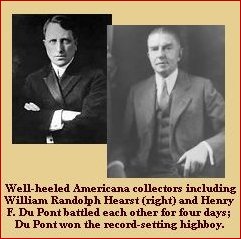 In the opening decades of the 20th century Philadelphia was home to a man whose name has become legend among collectors of American furniture. Howard Reifsnyder was a wealthy Philadelphia wool merchant whose taste turned to the antiquarian. He collected books, oriental ceramics & rugs, and American colonial furniture and arts. He did all this at a time, in a place, and with an enthusiasm and knowledge, which made it possible for him to assemble one of the finest collections of American colonial furniture ever made.
In the opening decades of the 20th century Philadelphia was home to a man whose name has become legend among collectors of American furniture. Howard Reifsnyder was a wealthy Philadelphia wool merchant whose taste turned to the antiquarian. He collected books, oriental ceramics & rugs, and American colonial furniture and arts. He did all this at a time, in a place, and with an enthusiasm and knowledge, which made it possible for him to assemble one of the finest collections of American colonial furniture ever made.Like other pioneering collectors of his day, Reifsnyder prowled the countryside buying up the Colonial and Federal-era artiftacts that fine art and antiques dealers scorned. His main hunting grounds- "Pennsylvania-Dutch" country, eastern Pennsylvania and Philadelphia allowed him access to furniture that was from the finest traditons of American cabinetmaking. And he bought and bought and bought...
The Magazine Antiques called him an " a vital and endearing personality" and Reifsnyder was generous with his knowledge and his antiques- his home was always open to the student, scholar and connoisseur, and he lent his treasures freely to museums, with the consequence that by the time he died his collection was known and envied throughout Americana collecting circles. By the time the collection was packed up and shipped to the American Art Association in New York for auction, the collecting world was waiting with baited breath, envious eyes, and open wallets.
For four days in April, 1929, collectors battled each other in the halls of the American Art Association as Major Parke knocked down lot after lot for staggering prices. A reporter for International Studio described the crowd as full of "connoisseurs of practically unlimited means or agents with unlimited reserves”, and claimed that such a battle of collectors “will probably never be duplicated in an American salesroom”, as Hearst and Garvan and Du Pont and other prominent collectors beat each other senseless with their paddles. The height was reached by the Van Pelt family highboy which was coveted by both Hearst and Du Pont, with Du Pont (using the name H.F. Winthrop) finally winning for a record-setting $44,000.
As Towner sums it all up in ‘The Elegant Auctioneers’-
“It took the explosive Howard Reifsnyder sale of April, 1929 to broadcast the fact that a highboy made in colonial Philadelphia could be worth as much as a ‘secretaire a abattant’ made for Marie Antoinette... In the giddy antique market of that Spring the Reifsnyder doings were a revelation, the repercussions wide and long-lasting. Native works of skilled craftsmen gained immeasurable prestige, and to this day, the auction is considered historic in the chronicles of collecting events. Forthwith, in the 1929 spender’s gambol, colonial highboys became the quarry of the house-proud and the stylish. Authentic pieces were called priceless, their value multiplied; and the AAA was credited, if not with the discovery of America, at least with its multitudinous exploitation”.
Speaking of auctions... we have a new printed catalog of auction catalogs available, please ask us to send you a copy, or you can browse it on our website.

No comments:
Post a Comment